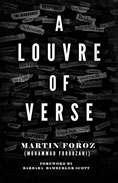
 |
with those he left behind when one day he said to all of them goodbye"
Foroz's appreciation for the poets that came before him and his knack for bringing words to life is on full display throughout as he presses forward with a focused mindset on using his experiences and observations to explore the depth of meaning in its many capacities. Divided into two primary sections, the first is an ode to poetic influences ranging from T.S. Eliot to Walt Whitman. The second speaks to monumental events that share universal qualities and reverberate through the reader's own experiences.
Foroz fully understands the inherent nature of meaning-making: each individual's experiences, philosophies, and values comprise the meaning given to a particular poem or scene. Upon examination of the title itself, a surface-level analysis undoubtedly points to a Mount Rushmore of poetry heavyweights. However, digging deeper, speaking the word "louvre" out loud shares a considerable resemblance to "love." More than simply a homage to the greats of poetry, Foroz's poetry is his own expression of love, an ode to the majesty and grace of the word.
The opening poem, "Faded Manifestations," wastes no time demonstrating its inspiration derived from Edgar Allan Poe's "The Raven." Specifically, Foroz uses phrases like "thin film" and "floating fleetingly," similar to Poe's use of "each separate dying ember wrought its ghost upon the floor" to create a crevice in reality by which both poets can escape their burdens of loss. With Poe, it is his beloved, Lenore, while for the speaker in "Faded Manifestations," it is Black Rose, the speaker's two-year-old daughter. Throughout this piece, Foroz juxtaposes the inevitability of death with freedom from the burden of memory. Though the parallels are many, Foroz doesn't miss the opportunity to dissect the meaning of "nevermore" and give it his own spin.
Foroz also suggests that growth as a writer stems from time. In his fifth decade, his experience as a veteran poet has helped him understand the need to let his characters and story take over. This allows him to harness his characters' and speakers' energy, resulting in an organic creation while still adhering to the rules of verse. In many ways, part and parcel of his essence are embedded within each of the characters. As he denotes, he has lived these experiences, but it is how they are given meaning by the audience that makes the work special. In the "Solid Kind," a reverence toward T.S. Eliot's "Hollow Men" leads to a stylistic and content tribute, particularly in the image of the fearful man and the subtle reference to The Wizard of Oz and its themes of courage and heart. While Eliot's poem requests audiences to remember humanity not as violent men but "As the hollow men, the stuffed men," Foroz uses repetition to respond, portraying humanity as solid rather than hollow in its grandeur, strong in both mind and body. Depicting an awakened humanity unafraid to use its voice to build unity is especially intriguing because of how similar it is to actual movements like Black Lives Matter that demonstrate the strength of an individual voice when it comes together.
The focus on Eliot continues with perhaps Foroz's most comprehensive work, "The Fourth Character," a stirring adaptation of "Four Quartets." At this stage, Foroz's commentary weaves in the actual verses from the "Four Quartets." Throughout four acts and over fifty scenes, Foroz allows his characters to take the lead. The result is a riveting inspection of not only time, led by the character described as the fourth actor, but Eliot's original work itself. Probing deeper into Eliot's idea that the past and present are contained in the future, the speaker ropes in references to Nietzche and Locke, ultimately conveying his thoughts on time with a pinch of humor with lines like "while he's signing out from a social medium that takes Time for slaughter."
Clearly, the poet's command of language is established from the get-go. As the compilation progresses, his wealth of knowledge, too, is noticeable. At times, his work draws parallels to Dante's Inferno, while at other times, references to universally recognized figures like Michelangelo and Darwin create an instant, vivid, and relatable connection. As the transition from Book One to Book Two occurs, Foroz's tendency to play with words and structure intensifies into Ginsberg-esque, vibrant poems that should be read aloud. Poems like "Lost" are literally structured in a manner where the word "lost" is, in fact, lost on the page. Meanwhile, "The Tree" has a descending structure that unmistakably takes the form of a tree. Tackling numerous current events with uncanny tact, Foroz's talent lies in his ability to peel back the curtain both of time and his own experiences without the bias or insinuation of any particular meaning. Like a cleverly situated anagram, the poems within this compilation will present themselves to the reader from the lens of their own experiences.
Just as when visiting the Louvre a single walk-through is insufficient, so one read-through is simply not enough. Recruiting the voices of the past to help shape the poet's present voice, Foroz's work is a thought-provoking tour de force of the written word, an experience that reels the reader in from the first page and keeps one thinking long after the last page has been turned.
RECOMMENDED by the US Review
Foroz was a 2020 Eric Hoffer Book Award Category Finalist.